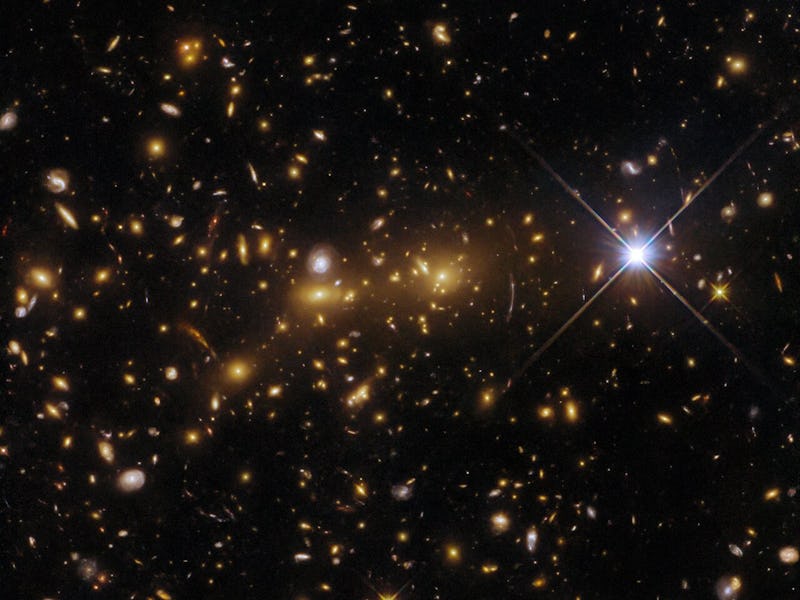Hubble Telescope Spots Bizarre "Magnifying Glass" Optical Illusion Predicted by Einstein
Gravitational lensing appears in new image from the Hubble Space Telescope.

A new image from the Hubble Space Telescope reveals the funny things that galaxies can achieve when they huddle together.
When galaxies are far enough away, the 33-year old observatory gets a sort of birds-eye view. Astronomers studying such Hubble imagery begin to notice how galaxies organize together, and when they play with the rules of physics. Peer close enough to the center of a new image, published Monday by one of the space agencies that runs Hubble, and out pops the tell-tale signs of a distortion known as gravitational lensing.
The phenomenon’s trademark is a subtle visual trick — right of center, there is a thin streak. It’s not a real object, but rather a manipulation of space-time. Gravitational lensing can “distort the images of background galaxies, turning them into streaks of light,” European Space Agency (ESA) officials wrote in an image description published Monday.
A Hubble Space Telescope image of eMACS J1353.7+4329. Behind the foreground star of the Milky Way (the bright object on the right), a myriad of galaxies huddle together as two clusters on the brink of merging into one behemoth cluster. Right of center, a streak reveals the warp of spacetime produced by the collective gravity of numerous galaxies.
Why does the light look warped?
Albert Einstein's general theory of relativity predicts that light’s path through space can change if enough mass is pooled into one spot.
“Gravitational lensing is a dramatic example of Einstein’s general theory of relativity in action. A celestial body such as a galaxy cluster is sufficiently massive to distort spacetime, which causes the path of light around the object to be visibly bent as if by a vast lens,” ESA officials write.
There are actually two galaxy clusters in the new Hubble image, a scene collectively known as eMACS J1353.7+4329. This “throng” is on its way to merging into one behemoth galaxy cluster, likely capable of even more warp.
Hubble has such a wide scope because this scene is playing out 8 billion light-years from Earth. To view this distant clash, Hubble peered into the northern constellation Canes Venatici (the Hunting Dogs), which is on the heels of Ursa Major (the Great Bear) and close to the Big Dipper.
In pursuit of a deeper view
Gravitational lensing is a striking visual. It’s also a helpful tool for astronomers wanting to see really far back in time.
Light is very fast, but ultimately, it has a finite speed. When astronomers look at eMACS J1353.7+4329, they are viewing light that took 8 billion years to reach Hubble in Earth orbit. And if a galaxy much farther away than this cluster happens to sit directly behind the galaxy cluster from Earth’s perspective, its light could not only get bent, but magnified.
Gravitational lensing is a new frontier for astronomy, potentially revealing objects too far away and too dim to see on their own, hiding away in the ancient universe.